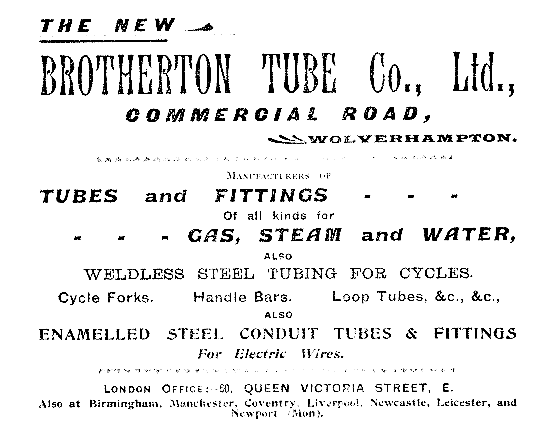|
On 24th June,
1882 Paul Bedford Elwell purchased part of the
building for the use of his company; The Patent
Tip & Horse Shoe Company. Details of the company
can be found elsewhere in this section. After
joining forces with Thomas Parker to form Elwell-Parker
Limited, Elwell leased his part of the building
to Elwell-Parker Limited on 1st
September, 1886. On 12th March, 1887
Elwell-Parker Limited began to rent another part of the
building from John Ryan Danks and Benjamin Danks.
On 8th
September, 1887 Elwell-Parker Limited purchased
Paul Bedford Elwell’s part of the property,
which they owned until 16th June,
1890 when it was sold to the Electric
Construction Corporation, which they became part
of.
The Electric Construction
Corporation sold their part of the building to
John Brotherton and Francis Simms for the use of
Brotherton Tubes Limited. The company seems to
have acquired much of the property, which was
conveyed to the New Brotherton Tube Company
Limited on 26th October, 1897. In
1903 another part of the building was occupied
by the Metropolitan Bank of England and Wales
Limited.

An advert from 1902.
In 1901 Wolverhampton
Corporation purchased another part of the
building, and sold it to the New Brotherton Tube
Company Limited on 26th
February, 1903. In 1912 Brotherton Tubes and
Conduits Limited leased another part of the
building, which they purchased on 13th
February, 1920. The story of Brotherton Tubes
can be found in part 1.
On 28th October,
1925 motorcycle manufacturer A. J. Stevens and
Company (1914) Limited purchased the whole of
the building, or at least the land on which it
stood. It may have been demolished before they
purchased the site, if not they demolished the
building. Nothing seems to be known about
their activities on the site. At the time
they produced motorcycles, sidecars, car bodies,
and radios. Their story will be found in part 3.
A. J. Stevens went into
voluntary liquidation in 1931. The land was sold
towards the end of 1934 to W. E. Jones, timber merchants and
timber importers, who occupied the site for many
years. |